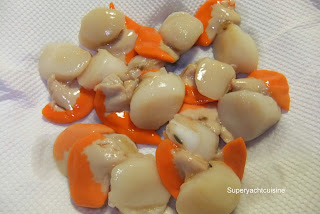Mercury, how much is to much?
Mercury is an increasing problem in our food chain, the knowledge about this subject is important for all chefs/cooks especially in the superyacht industry where chefs are responsible for the daily dietary intake of the crew and guests.
According to the Natural Resource defence council (NRDC) <http://www.nrdc.org/health/effects/mercury/index.asp> when Mercury is consumed it releases neurotoxins into the body which badly effects the brain and nervous system. The most at risk are children, pregnant and breast feeding mothers.
How does mercury get into our environment? mercury is a natural element, according to NRDC <http://www.nrdc.org/health/effects/mercury/effects.asp> the contamination begins with industrial and manufacturing industries, coal fired power plants, cement factories, chemical manufactures, pulp and paper milling, coal and oil are very high in mercury, their waste products seep into the environment ending up in the earths waterways. From there it is a chain reaction.
Chain Reaction
Waterways polluted with mercury through industry or natural occurring events such as a volcanic eruption
Natural bacterial in the waterways absorb the mercury
and convert it to methyl mercury.
The little fish eat the natural bacterial containing
the methyl mercury.
Bigger fish eat the little fish,
until fish such as tuna, sword fish, shark and mackerel contain 10,000 times more
methyl mercury than there surrounding habitat.
Methyl mercury from seafood can easily be absorbed by the human body. People especially
vulnerable are children, and women of childbearing age who can become pregnant
and breastfeed.
A list of seafood mercury levels between 1990 - 2010 can be viewed at
Seafood mercury contamination a brief look
High levels of mercury contamination
King Mackerel
Shark
Swordfish
Tile fish - Gulf of Mexico
Tuna - Big eye
Moderate level of mercury contamination
Group all species
Chilean bass
Blue fish
Spanish Mackerel - Gulf of Mexico
Orange roughy
Tuna, yellow fin, albacore
Low level of mercury contamination
Spiny lobster
Hake
Cod
Butter Fish
Haddock (Atlantic)
Salmon
Scallops
North Atlantic mackerel
Shrimp
Mercury Calculator
A awesome way to check out how much is too much seafood mercury consumption is to use the mercury calculator at http://www.nrdc.org/health/effects/mercury/calculator/calc.asp simple tick the box your weight and it will calculate the risk.
Find out more information
Farm raised seafood
This information above is largely from the US, I have a question 'mercury contamination in seafood must vary on location e.g. New Zealand has very low industry, so are the fish lower in mercury?' hmmmmm.



Comments
Post a Comment